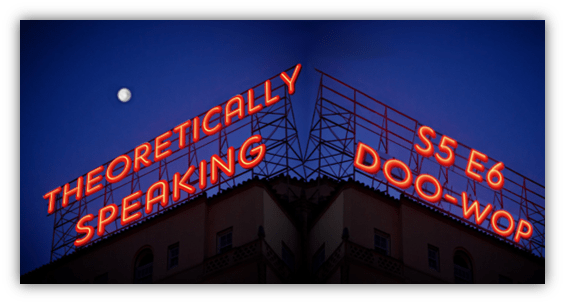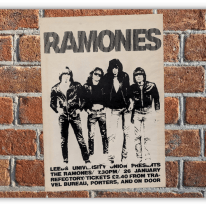So…

and Crooning…
…bring us here:
To street corners in the 1950s.
Barbershop started with men gathering in, well, barber shops. In the 50s, teenagers in east coast cities like Baltimore, Philadelphia, and New York, gathered under street lamps. As soon as it got dark enough for the lights to come on, groups would get together and sing.

It got to the point where they’d stake out the best corner to sing on.
What makes one corner better than another? The best corner had the most girls nearby.
And the groups with the best harmonies got the most girls. These singers are old men now, but still tell their stories with gleams in their eyes. They appreciated the brotherhood and camaraderie of singing with their neighbors, but the girls made it extra special.
Unlike barbershop, doo-wop harmonies didn’t go heavy on the dominant seventh chord.
They were more inspired by the crooners they heard on the radio, in terms of both rhythm and tone.

Groups used the swing rhythms of the big bands and jazz singers, as well as the soft, sweet tones of the crooners.
Early doo-wop followed the crooning style of slow ballads, but instead of a single singer and a band, doo-wop used four or more voices singing in harmony and no band at all.

They didn’t use instruments, not at first anyway, in part because they couldn’t afford any.
Besides, all you needed were fingersnaps and beautiful voices.
Also, where barbershop groups sang in four part harmony, in doo-wop each member might have his own part separate from the others. There could be a long falsetto note over someone else singing “la las” or “na nas” or some other sound rhythmically. And these could be completely different from the main melody line.
The Orioles were the first doo-wop group to have a national hit with 1948’s “It’s Too Soon To Know.”
It was so popular that many groups covered it.

They followed that up the next year with “Tell Me So” and many hits after that.
They were a sensation. Lead singer Sonny Til was a heartthrob, like Frank Sinatra. Their shows are the first instances of women throwing their underwear on stage.
I guess it’s better than having pennies thrown into your megaphone.
Many of these songs used the same chord pattern. It was a variant of the I-vi-ii-V pattern sometimes used in jazz, but they replaced the ii chord with a IV chord. In the key of C, that would be C, A minor, F, and G. You’ve heard it a million times whether you know it or not.
If you told a musician to play doo-wop chords, it’s probably what they’d play. Think of “Duke of Earl.“

The entire song is the I-vi-IV-V pattern played over and over. The only variation is sometimes each chord lasts one measure and sometimes they last two measures.
Some groups learned that they sounded even better if they moved from the sidewalks to apartment building stairwells because the sound echoed off the walls. Bathrooms also added nice reverb. Subway stations, between trains, had good reverb, too, and that’s where The Crests were discovered in 1956.
Studios often added reverb to make things sound bigger, and singing indoors mimics that studio reverb.

The way studios did it was to use either an echo chamber or a reverb device. An echo chamber is a room with a speaker on one side and a microphone on the other, and not much else.
The speaker and the mic aren’t lined up directly across from each other, so the sound bounces off the walls irregularly before getting captured by the microphone.

The same sound hits the mic multiple times because it bounced off different surfaces. The few milliseconds difference adds warmth and makes everything sound bigger.

A reverb device might be a plate of metal that vibrates with the sound and creates the milliseconds of delay we hear. There’s also spring reverb and other devices.
And nowadays it’s all done with software.
Though these groups usually sang a capella, instruments were often added in studio recordings.
A New York group called The Harp-Tones recorded two versions of “My Memories Of You.”

The 1954 version is almost all vocals, with piano, and possibly some other instruments, so far in the background that they might as well not be there at all.
Their 1956 recording has a full band as prominent in the mix as the vocals.
The recording industry had been around for over half a century, and through all that time they marketed music to adults.
There might be a kiddie song here or there, but no one thought about making music for teenagers. After all, teens didn’t have any money…

…until the 1950s.
The economy boomed (and so did the babies) after WWII and through the Eisenhower years. Teens got allowances and worked part-time jobs. Most spent their money on movies and music.
In 1956, Frankie Lymon & The Teenagers became the first teenaged group to perform on national television. Appearing on The Frankie Laine Show, they burst into America’s living rooms by jumping over a wall to join the host. It was a youthful move, and unlike any entrance on television up to then. Kids noticed.

They performed their #1 song “Why Do Fools Fall In Love?” and the next day, groups across the country thought, “If they can become a national act, we can, too!” And record labels thought, “We need more teenage groups!”
Unfortunately, the industry knew that kids and their parents didn’t understand how record contracts work. Artists signed their rights away without knowing, and without being told, what they were signing.
Anthony Gourdine of Little Anthony & The Imperials, whose first single “Tears On My Pillow” hit #4 and sold over a million copies, said, “Somebody got the money. It sure wasn’t me.”
Frankie Lymon was 13 years old when The Teenagers had their television debut. It led to more hits and tours but the band broke up the following year. There were many reasons, including their voices changing as they matured, but a main one was that their management thought Lymon could be a star on his own.
He had no hit songs without The Teenagers, and The Teenagers had no hits without Lymon.

Frankie had a couple failed recording contracts, a marriage that wasn’t legal because his wife was still married to someone else, and a child who died two days after birth.
He turned to drugs and alcohol and died of a heroin overdose in 1968. He was 25.
Doo-wop songs often had a sing-speak part in the middle that talked directly to the singer’s object of desire.
These contrasting sections add variety and theatrical drama. In a way, it’s even more intimate than crooning. It’s tempting to say that these spoken parts were inspired by the recitative sections of operas, but it’s more likely to come from gospel.

Especially in black churches, preachers often spoke over light piano music.
Also, we can probably credit gospel’s call-and-response for the backing vocals in doo-wop. Instead of singing “Amen” or something similar, doo-wop groups used nonsense syllables, like “sh-boom,” “wah”, and of course, “doo.”
And “wop.”

The low volume of crooning allowed the harmonies to be softer than in barbershop.
So to get to the sweet voices under 1950s street lamps, we need the group harmonies of barbershop, the call-and-response and recitive of gospel, and the softer vocals of crooning.
As with many of the genres we’ve looked at here, doo-wop was started in black communities.

In many east coast cities, the Italian neighborhoods were near the black neighborhoods, and doo-wop crossed over. That’s one reason why so many of the white doo-wop singers were of Italian descent: Dion And The Belmonts, The Elegants, and The Capris. The Crests were one of the few integrated groups.
Alan Freed was a radio DJ, first in Akron, then Cleveland, and then New York City.
His success is based on his love for white and black music, and playing both on the air. There was some backlash, especially in the south.
Likewise, DJ Dick Clark began taking bands on the road in a series of bus tours.

It would be black and white groups together on the bus, on stage, and in restaurants and hotels, except in the south. There, they had to stay in separate hotels, and the white hotels were always nicer.
The black artists would have to get their meals to go and eat on the bus because there weren’t allowed to sit in the restaurants.
On stage, black male singers had to look at the wall so they couldn’t be accused of looking at the local white women. The Flamingos had a huge hit with “I Only Have Eyes For You,” but they couldn’t put their photo on the album cover.

Some stores wouldn’t carry records with black faces. The cover features a picture of flamingos.
The Coasters, on their own tour, did a show in Dallas with a rope leading from the stage to the back of the hall, splitting the audience in two. Whites were on one side, and blacks were on the other. Integrated couples danced holding hands over the rope.

The group stopped the show and asked the promoter to loosen the rope so people could dance together. “From then on,” Coaster Leon Hughes said, “we had mixed crowds.”
Audiences, kids really, recognized that music was only one part of society, and there was a whole lot more that needed to change. Removing a rope is one thing, fixing a broken society is another.

But in its small way, doo-wop helped prepare young minds for the upcoming changes. It’s hard to say how much it contributed to the civil rights movement of the 60s, but it did.
Doo-wop and blues and country and gospel merged into rock and roll. You can hear those doo-wop harmonies in the surf music of The Beach Boys, the soul of Motown, and even early Beatles.
And it was The Beatles and the British invasion that killed doo-wop as a popular genre.
While its legacy is in every current boy band or girl group – even the ones from Korea – vocal harmony isn’t necessarily the focus anymore. It’s just an ingredient.
In 1969, Sha Na Na appeared at Woodstock.

With their retro clothes, greased hair, and doo-wop harmonies, they seemed like a novelty act from a bygone era. It was only five years after the British invasion.
That’s how much the 60s changed everything.
Suggested Listening – Full YouTube Playlist

It’s Too Soon To Know
The Orioles
1948

Sixty Minute Man
Billy Ward And His Dominoes
1951

My Memories Of You
The Harp-Tones
1954

Why Do Fools Fall In Love?
Frankie Lymon And The Teenagers
1956

In The Still Of The Night
The Five Satins
1956

Little Darlin’
The Diamonds
1957

Youngblood
The Coasters
1957

Maybe
The Chantels
1957

Tears On My Pillow
Little Anthony And The Imperials
1958

Little Star
The Elegants
1958

There’s A Moon Out Tonight
The Capris
1959

I Only Have Eyes For You
The Flamingos
1959

Teenager In Love
Dion And The Belmonts
1959

Step By Step
The Crests
1960

Duke Of Earl
Gene Chandler
1962
Let the author know that you liked their article with a “Green Thumb” Upvote!







Lots of fun, as always, and interesting to see how the dots are connecting …
I can think of a few follow-ups to this by thinking of where vocal music went next but why spoil the fun of seeing what pops up in future installments?
I will say of all the later homages to the sound, my favorites would include Boyz II Men’s “End of the Road” and “It’s So Hard to Say Goodbye to Yesterday,” Wet Willie’s “Street Corner Serenade,” Billy Joel’s “The Longest Time,” and even the Beach Boys’ “Barbara Ann.” I love “Street Singin’” by Lady Flash, Barry Manilow’s backing group, but I’m not sure how much of that is doo-wop and how much is “Wall of Sound.”
I grew up with a 4 record set of 50s/early 60s hits that my dad bought (probably around the time of American Graffiti). I have a certain reverence in my heart for a lot of those tunes, and a lot of them were this doo-wop style.
Thank you for including the Flamingoes “I Only Have Eyes for You”, which I have said before might be one of the best songs released in the 20th century (in my humble opinion). I’m not always a huge fan of echo chamber and its muddy sounding results, but I sure do love it in that song.
How fun would it be to gather on a street corner and just sing songs together? That would be fun in any time period.
No “e”s in Flamingos…
Great catch! Don’t need another Dan Quayle… 😜
Meet you at 28th and Elm at 7:30.
❤
Right in the heart of America. Cairo, IL
https://goo.gl/maps/qNgBs1Yn2RHnqw9u9
Perfect. There’s a streetlight and everything.
Nice. We all could use a little more shbop-shbops in our lives.
Apparently an important factor in teenagers becoming a viable demographic for the music industry to court is the rise of juke boxes. With just a nickel, kids could cast their votes for songs they liked. As more businesses included juke boxes to their patrons, record companies began to pay attention to the most popular numbers. Thus, the surprise success of rock ‘n’ roll, including doo-wop.
You’ve got so many great numbers here already, so I can only think to include this one, a favorite from my childhood (and perfectly used in An American Werewolf in London). Love those lower register vox.
https://www.youtube.com/watch?v=qoi3TH59ZEs
I very nearly included “Blue Moon.” It hit #1, after all.
Good point about the jukeboxes.
So jukeboxes are the grandfather of SoundScan, another technology that provided real data about what music was being listened to. (And I suppose, then, the great-grandfather of Spotify.)
A lot less spammable than Spotify (save for rich kids with suitcases full of nickels?), but pretty much.
And with the British Invasion having brought about the end of doo-wop it was only a few short years from Sha Na Na reviving it to British acts like Showaddywaddy recycling it in the 70s.
I’ll second Link’s assessment of I Only Have Eyes For you. Just a stunning record. It took an ad for Amazon Alexa to bring it back to prominence last year and remind me of it. I was paying a lot more attention to the music than the product.
“Screamin'” Scott surpassed Bowzer in my Sha Na Na pantheon when he bathed in the afterglow of John Travolta’s limelight by performing his own composition, “Sandy”.
Thanks, Bill! Your music knowledge from a technical standpoint makes this greenhorn think a little deeper about why I like the music I do. It reminds of Alan Pollock’s similar examination of the full run of Beatles’ songs (https://www.icce.rug.nl/~soundscapes/DATABASES/AWP/awp-alphabet.shtml), which I turn to quite often, despite never figuring out what a home key is.
“Home key” is just another phrase meaning what key the song is in. If it’s in C, the home key is C. It’s nothing more complicated than that.
Thanks for the great website! It looks like a really good resource.
Wow! That website is a wealth of info! I just looked up one of my favorite obscure tracks, “Yes It Is” (flip side of “Ticket to Ride”) and I’m loving the write-up. Even if some of it is beyond me.
My first boombox came with my mother’s taste in music. It came with two volumes of Elton John hits and five volumes of Oldies But Goodies. It had…
Songs you featured: “Sixty-Minute Man”, “Maybe”, “In the Still of the Night”, and “Duke of Earl”
Artists you featured w/different songs: “Two People in the World”(maybe too intense to crossover into pop charts), “Lovers Never Say Goodbye”(epic).
My favorite song from the series wasn’t doo-wop: “Don’t You Just Know It”. Super-fun call and response.
The Greek choir in Little Shop of Horrors, the inspiration for the amazing Darlene Love song that appeared on SNL, is that doo-wop?
I’d say they’re more early 60s R&B girl group with a touch of calypso. That’s what I hear anyway, your mileage may vary.